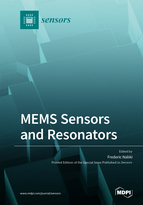MEMS Sensors and Resonators
A special issue of Sensors (ISSN 1424-8220). This special issue belongs to the section "Physical Sensors".
Deadline for manuscript submissions: closed (30 June 2019) | Viewed by 46493
Special Issue Editor
Interests: analog and mixed-signal integrated circuits; integrated sensors; integration of MEMS with electronics; MEMS sensors and actuators; microelectromechanical systems (MEMS); micro-fabrication; radiofrequency integrated circuits (RFICs); resonant MEMS; sensor interface circuits; ultra-wideband impulse radio (IR-UWB)
Special Issues, Collections and Topics in MDPI journals
Special Issue Information
Dear Colleagues,
Microelectromechanical systems (MEMS) have had a profound impact in a wide range of applications. The degree of miniaturization made possible by MEMS technology has significantly improved the functionalities of many systems, and the performance of MEMS has been steadily improving with ever-increasing use cases. Notably, MEMS sensors have been prevalent in motion sensing applications for decades, and the sensing mechanisms leveraged by MEMS have continuously been expanding to applications spanning the detection of gases, magnetic fields, electromagnetic radiation and many more. In parallel, MEMS resonators have become an emerging field of MEMS touching fields such as electronic timing and filtering, and energy harvesting, and they have enabled a wide range of resonant sensors. For many years now, MEMS have been the basis of many industrial successes, often building on novel academic research.
Accordingly, this Special Issue invites authors from academia and industry to share their research innovations in MEMS sensors and resonators, touching on devices enabled by MEMS such as, but not limited to:
- accelerometers, gyroscopes and inertial measurement units
- bio sensors
- bolometers
- gas sensors
- magnetometers
- micro-mechanical filters
- micro-resonator-based timing systems
- micro-resonators
- microphones
- pressure sensors
- resonant energy harvesting
- resonant sensors
- ultrasonic transducers
Prof. Dr. Frederic Nabki
Guest Editor
Manuscript Submission Information
Manuscripts should be submitted online at www.mdpi.com by registering and logging in to this website. Once you are registered, click here to go to the submission form. Manuscripts can be submitted until the deadline. All submissions that pass pre-check are peer-reviewed. Accepted papers will be published continuously in the journal (as soon as accepted) and will be listed together on the special issue website. Research articles, review articles as well as short communications are invited. For planned papers, a title and short abstract (about 100 words) can be sent to the Editorial Office for announcement on this website.
Submitted manuscripts should not have been published previously, nor be under consideration for publication elsewhere (except conference proceedings papers). All manuscripts are thoroughly refereed through a single-blind peer-review process. A guide for authors and other relevant information for submission of manuscripts is available on the Instructions for Authors page. Sensors is an international peer-reviewed open access semimonthly journal published by MDPI.
Please visit the Instructions for Authors page before submitting a manuscript. The Article Processing Charge (APC) for publication in this open access journal is 2600 CHF (Swiss Francs). Submitted papers should be well formatted and use good English. Authors may use MDPI's English editing service prior to publication or during author revisions.
Keywords
- Electromagnetic sensing
- Gas sensing
- MEMS resonators
- MEMS sensors
- Motion sensing
- Resonant structures
- Ultrasonic sensing







